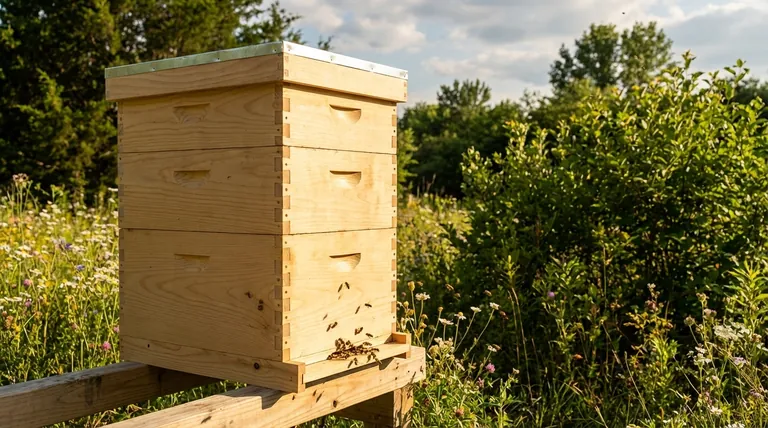For most beekeepers, especially in temperate or colder climates, the standard and recommended configuration is two deep brood boxes. This setup provides ample space for the queen to lay eggs, which builds a large, robust colony, and offers enough room for the food stores necessary to survive winter.
The decision between one and two brood boxes is a fundamental choice in hive management. It balances the need for a large, healthy colony against the physical demands of hive inspection, with your local climate being the most critical deciding factor.

Why Two Brood Boxes is the Standard
The two-box system is the most common for a reason. It is designed to mimic the natural space a wild colony would occupy and creates a more forgiving environment for both the bees and the beekeeper.
Maximizing Queen Laying Potential
A healthy queen can lay over 1,500 eggs per day. A single deep box does not provide enough cells for her to maintain this pace while also accommodating pollen, nectar, and developing brood.
Two deep boxes give the queen unrestricted space to lay. This ensures the colony can build its population to maximum strength during the peak season.
Building a Stronger Workforce
A larger brood area directly translates to a larger population of bees. A stronger workforce means more foragers collecting nectar and pollen, leading to better pollination and a larger potential honey harvest.
Simplified Feeding and Overwintering
With two boxes, you can provide larger quantities of feed less frequently. This reduces the number of times you need to disturb the hive.
Critically, for colonies in colder climates, the second box is essential for storing the honey and pollen required to survive the long winter months when no forage is available.
The Case for a Single Brood Box
While less common, some beekeepers successfully use a single brood box. This approach requires more active management but offers distinct advantages in specific situations.
Lighter Lifts and Faster Inspections
The primary benefit of a single-brood-chamber hive is its weight. A deep box full of honey and brood can be extremely heavy. Working with a single box makes hive inspections physically easier and faster.
Suitability for Warmer Climates
In regions with short or mild winters and a long nectar flow, bees do not need the extensive winter stores required in the north. A single box can be sufficient for the colony's year-round needs in these specific climates.
Understanding the Trade-offs
Neither system is universally perfect. The right choice depends on a clear understanding of the compromises you are making.
Climate Is the Deciding Factor
For beekeepers in areas with cold, long winters, using two brood boxes is a matter of survival. A single deep box simply cannot hold enough honey stores to sustain the colony through winter, making it a high-risk strategy.
In contrast, beekeepers in the southern United States or other warm climates have the flexibility to choose a single-box system because the colony's need for winter food stores is significantly lower.
Swarm Management Intensity
A single brood box will become crowded more quickly, which can trigger the swarm impulse sooner and more frequently. This requires the beekeeper to be more vigilant with weekly inspections during the spring buildup to prevent losing half their colony.
A two-box system provides more space, delaying the feeling of congestion and giving the beekeeper a wider margin for error in swarm management.
Making the Right Choice for Your Apiary
Your decision should be based on your climate, your physical ability, and your beekeeping goals.
- If your primary focus is colony survival and you are a new beekeeper: Start with two deep brood boxes. This is the most forgiving and time-tested method for most regions.
- If your primary focus is reducing heavy lifting and you live in a warm climate: A single deep brood box is a viable option, but be prepared for more frequent swarm management.
- If your primary focus is maximizing honey production in a temperate climate: The large population generated by a two-box system will provide the strong foraging force needed for a substantial harvest.
Ultimately, aligning your hive configuration with your local environment and management style is the key to successful beekeeping.
Summary Table:
| Configuration | Best For | Key Advantage | Key Consideration |
|---|---|---|---|
| Two Deep Boxes | Temperate/Cold Climates, New Beekeepers | Maximizes colony strength & winter survival | Heavier to manage |
| One Deep Box | Warm Climates, Beekeepers seeking lighter hives | Easier, faster inspections | Requires more frequent swarm management |
Ready to build a stronger, more productive apiary?
At HONESTBEE, we supply commercial apiaries and beekeeping equipment distributors with the high-quality, durable supplies needed for success. Whether you're standardizing on a two-deep-box system or optimizing for a specific climate, our wholesale-focused operations ensure you get the right equipment for your scale and goals.
Let's discuss your needs and build a more resilient beekeeping operation together.
Contact our expert team today for a quote!
Visual Guide

Related Products
- Australian Langstroth Beehive Boxes for Beekeeping Wholesales
- Langstroth Honey Bee Box Hive Boxes for Different Depths
- Langstroth Bee Hives Bee Keeping Box for Beginners Beekeeping
- Portable Bee Mating Hive Boxes Mini Mating Nucs 8 Frames for Queen Rearing
- Australian Pine Wood Langstroth Screen Bottom Board for Wholesale
People Also Ask
- What color should beehives be painted? The Best Choice for Hive Health and Honey Production
- How many deep hive bodies should I use? The Standard for a Healthy, Winter-Ready Colony
- What is the purpose of reversing brood chambers in the spring? A Proactive Swarm Prevention Strategy
- What other types of hives are available besides the Flow Hive? Explore Langstroth, Top Bar, and Warre
- Why might a beginner be advised to start with a Langstroth hive? Unlock a Supportive Beekeeping Ecosystem



















